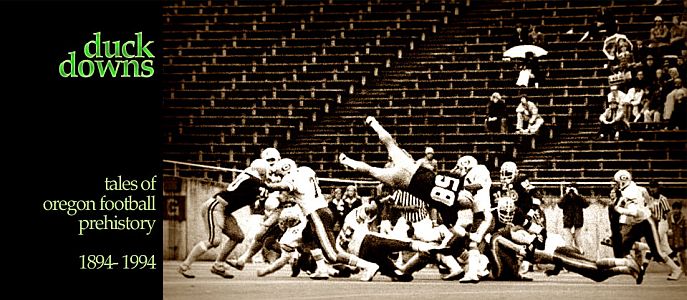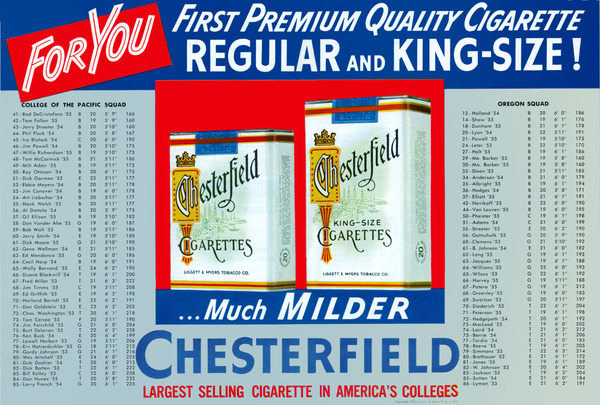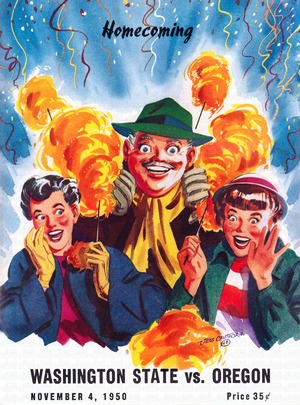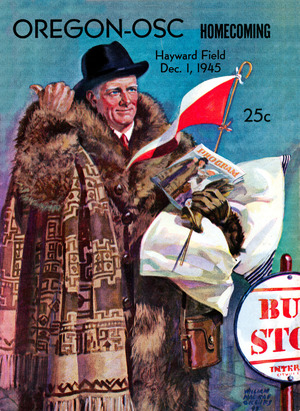November 1, 1952 – College of the Pacific at Oregon
 September 12, 2011
September 12, 2011  Those who worship the memory of Len Casanova – and they are legion, your faithful blogger included – sometimes forget that it took him a while to get things going his way. Coming out of the wreckage of Jim Aiken’s program, Cas went 5-19-1 over his first 25 games, and there were some frustrating moments; a three-game shutout streak in early 1953, a 49-0 debacle in Seattle in 1952… and home-and-home losses to College of the Pacific. The return match with the Tigers, a 14-6 Webfoots loss in Eugene, is the subject of this week’s program.
Those who worship the memory of Len Casanova – and they are legion, your faithful blogger included – sometimes forget that it took him a while to get things going his way. Coming out of the wreckage of Jim Aiken’s program, Cas went 5-19-1 over his first 25 games, and there were some frustrating moments; a three-game shutout streak in early 1953, a 49-0 debacle in Seattle in 1952… and home-and-home losses to College of the Pacific. The return match with the Tigers, a 14-6 Webfoots loss in Eugene, is the subject of this week’s program.
The game was played under fog and clouds that threatened but did not release, preserving a five-year streak of no rain at Hayward Field. (It is not known whether one of Don Essig’s predecessors uttered the immortal “It never rains at 15th and Agate!”) After being blown out 34-6 in ‘51, the Webfoots made a better accounting of themselves in the rematch; their first-quarter touchdown, an 84-yard strike from Hal Dunham to Ted Anderson, stood as the longest pass play in Oregon history until 1970. But Oregon couldn’t find the end zone again, and couldn’t withstand COP’s balanced attack, led by HB Tom McCormick, who scored both of the Tigers touchdowns.
(Oregon had its share of trouble with Pacific over the years, dropping 3 of the 7 contests before the Tigers folded their football tent in 1995, the third loss being a real doozy – the 1983 season opener at Autzen, where they were favored by three touchdowns.)
Program Notes:
- It was Election Week in America in 1952, and one can draw whatever conclusions one wishes from the fact that while the Republicans ticket purchased a full-page ad in the Oregon program (page 25), the Democrats couldn’t be bothered. (Eisenhower and Nixon held a distinct campaign advantage on the gridiron. Ike was a member of the powerful Army football teams of 1913-1916, and a teammate of former Oregon head coach Cap McEwan. Ike’s running mate was a JV tackling dummy in high school at Whittier, and later famously called a play for Washington during the 1971 NFL playoffs. There is no record of Adlai Stevenson ever donning pads and cleats, and although his VP candidate, John Sparkman, was from the football hotbed of Tuscaloosa, Alabama, the Democrats were trounced in the election.)
- In his only two seasons at the helm in Stockton, 1951 and 1952, Ernie Jorge guided COP to a Sun Bowl bid each year. But head coaching didn’t seem to be Jorge’s calling. (The questionable financial state of the program probably didn’t help; COP would only hire coaches on a one-year contract, and there was some discussion of dropping football altogether, as Santa Clara would for a few years after 1952.) Jorge moved on after the 1952 season to assistant coaching positions with the NFL Chicago Cardinals and, later, at Navy, under his friend and former Pacific assistant Wayne Hardin. (That’s the “Hardin” in the photo at the top of page 6.)
During his tenure with the Midshipmen, Jorge befriended the son of a fellow assistant coach, and each week sent the ten-year-old football junkie a copy of the Navy offensive game plan for the next game. The envelope was labeled “BILL’S READY LIST.” (The boy grew up to be Bill Belichick.) While on a scouting trip for his last employer, the Houston Oilers, Jorge suffered a fatal heart attack in his room at a Holiday Inn in Kent, Ohio; he was 51 years old. - Once again, the only color outside of the program’s cover is for tobacco advertising. The center spread, again brought to you by Chesterfield, is nondescript, but the other full-page ads feature a pair of comely lasses; unidentified on the back cover (Camel), but on the inside cover is Dorothy Collins herself, the “Sweetheart of Lucky Strike.” Collins was a star of Your Hit Parade, a weekly TV show featuring vocalists lip-synching popular songs of the day…
and it’s not a huge leap from this to American Idol, is it? (Collins died of respiratory distress in 1994, in one of life’s little ironies for a tobacco wench; she suffered from chronic asthma.) - The $2552.88 for a ‘52 Buick – delivered – in 1952 works out to around $21,000 in 2011. That RCA Victor TV on the inside back cover for $199.95? A little over $1600 today. You can buy a 1952 Buick Super from a dealer in Happy Valley for $8,499 as of today (9/12/11), and in the words of the seller, “gas it up and drive it to L.A. from Portland.” If you could find a 1952 RCA Victor television today, you’d see nothing but static… assuming it would fire up at all.





